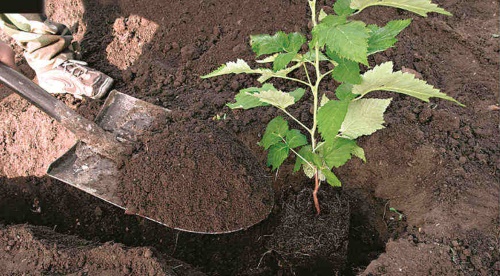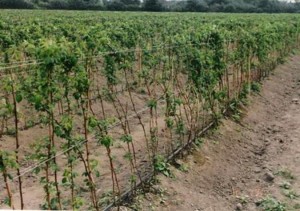More and more gardeners prefer remontant raspberry varieties. Depending on the variety, the yield of such raspberries ranges from 1.5 to 5 kg. berries from one bush. By planting such a plant in your garden, you can enjoy this tasty and very healthy berry from the end of June until the frost. In addition to the fact that these berries have an excellent delicate taste, they are also very transportable. This is important for people who grow raspberries for sale.
Planting remontant raspberries
Remontant raspberries are very demanding of sunlight. When planted in a shaded place, it will of course grow, but then don’t expect a good harvest. It should also not be planted on waterlogged soils or in areas where raspberries or some nightshade crops had already grown.
The best option is if planting is carried out in the fall. Before frost, it will have time to take root well and will quickly grow in the spring. You can plant in early spring before the buds open, but spring plantings will lag behind plants planted in the fall. If you managed to buy seedlings grown in containers, then they can be planted throughout the summer. Just don’t forget to shade them at first and water them more often.
Raspberries are planted either in bushes or in rows. When planting using the bush method, 3-4 plants are planted in one place, with a distance of 70-80 cm between them. Such bushes are well lit by the sun, they are easy to care for and harvest.
But most often, remontant raspberries are planted in rows. The distance between the rows should be at least 1.5 m, and between the bushes in a row 70-80 cm. Plants must be planted at the same depth at which they grew before, the root collar should be at ground level. Otherwise, the seedlings will not take root well.
When planting remontant raspberries, it is necessary to add organic matter to the soil. To do this, dig a trench 40 cm deep and 50-60 cm wide. Per 1 linear meter of the trench add 2 buckets of rotted manure, 1 cup of superphosphate and 1-2 cups of ash. Then soil is added there and everything is thoroughly mixed.
With this soil preparation, the bushes will have enough nutrients for several years. Of course, not everyone has the opportunity to carry out such pre-planting soil preparation. In this case, you will have to limit yourself to annual liquid feeding.
Caring for remontant raspberries
Caring for raspberries includes the following activities:
- feeding
- mulching
- watering
- pruning and thinning
Feeding remontant raspberries
Raspberries react very actively to the application of any organic fertilizer. Such fertilizers contain the entire range of nutrients necessary for plant development. Liquid fertilizing with fermented mullein is especially useful. To do this, 1 bucket of fresh manure is filled with 2 buckets of water. All this ferments for about 10 days, then 1 liter of fermented liquid is added to a bucket of water and applied under the raspberries at the rate of 3-5 liters. per 1 meter row.
At least two such feedings must be done. In spring and the first half of summer. Already in August, liquid nitrogen fertilizers cannot be applied. If it is not possible to buy manure, you should feed the raspberries with mineral fertilizers.
In spring, it is good to add nitroammophoska to the beds at the rate of 50-100g. per 1m\sq. You can also use complex mineral fertilizers. All fertilizing is carried out only after abundant watering.
Mulching
Agricultural technology for remontant raspberries involves regular loosening of the soil. But the root system of the plant is located superficially and when loosening it is easy to damage the roots. If the plantings are well mulched, then loosening can be abandoned altogether.
You can mulch with humus, hay, peat, etc. The mulch layer should be about 10 cm. Such a layer will prevent weeds from germinating, will retain moisture in the soil and, gradually rotting, will also serve as a fertilizer.
Watering
Raspberries need regular watering. Watering should be plentiful so that the soil gets wet to a depth of at least 30 cm. It is very important to water the plantings before flowering and the period of ripening of berries, as well as in the fall before wintering.
Pruning and thinning
When caring for raspberries, thinning is a mandatory step. It is necessary to remove excess shoots and root suckers as early as possible so that they do not shade the plantings and do not consume nutrients. On 1p. meter should grow no more than 10 - 12 shoots. Of which 5 - 6 overwintered and the same number of replacement shoots.
The most common mistake gardeners make is planting too thickly. In dense thickets, berries will only be on the tops of the plants.
A very important event is pruning remontant raspberries. Using different pruning methods, you get either two harvests, or one, but very abundant one. But this is a topic for another article.
YOU CAN ALSO READ:
Propagation of remontant raspberries
Black raspberry planting and care




 (2 ratings, average: 3,50 out of 5)
(2 ratings, average: 3,50 out of 5) CUCUMBERS NEVER GET SICK, I'VE BEEN USING ONLY THIS FOR 40 YEARS! I SHARE A SECRET WITH YOU, CUCUMBERS ARE LIKE THE PICTURE!
CUCUMBERS NEVER GET SICK, I'VE BEEN USING ONLY THIS FOR 40 YEARS! I SHARE A SECRET WITH YOU, CUCUMBERS ARE LIKE THE PICTURE! You can dig a bucket of potatoes from each bush. Do you think these are fairy tales? Watch the video
You can dig a bucket of potatoes from each bush. Do you think these are fairy tales? Watch the video
 How our fellow gardeners work in Korea. There is a lot to learn and just fun to watch.
How our fellow gardeners work in Korea. There is a lot to learn and just fun to watch. Eye trainer. The author claims that with daily viewing, vision is restored. They don't charge money for views.
Eye trainer. The author claims that with daily viewing, vision is restored. They don't charge money for views. A 3-ingredient cake recipe in 30 minutes is better than Napoleon. Simple and very tasty.
A 3-ingredient cake recipe in 30 minutes is better than Napoleon. Simple and very tasty. Therapeutic exercises for cervical osteochondrosis. A complete set of exercises.
Therapeutic exercises for cervical osteochondrosis. A complete set of exercises. Which indoor plants match your zodiac sign?
Which indoor plants match your zodiac sign? What about them? Excursion to German dachas.
What about them? Excursion to German dachas.
I wonder, have you seen anywhere that they would dig a 40 by 60 cm trench to plant raspberries? This is more like pouring a foundation rather than planting regular raspberries.
But after such preparation you will receive good harvests for many years. Pre-planting soil preparation is the key to future harvests.
If you are interested in good harvests, pre-planting preparation is the first thing!
It all depends on the composition of the soil. If the soil is good, then all you need to do is dig a hole the size of the roots, plant raspberries and enjoy good harvests.But if the soil is bad, then you will actually have to dig a trench. There's nothing you can do about it.